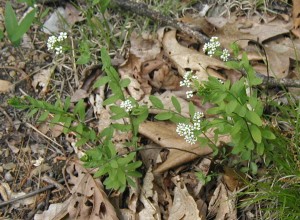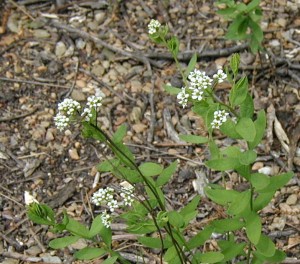I can’t believe anyone would name a plant Bastard Toadflax. That funny sounding name deserves some explanation, don’t you think?
The Audubon North American Field Guide to Wildflowers tells us that Bastard Toadflax, Comandra umbellata, is a parasitic plant associated with trees and shrubs. Because the little plant is green, which means it contains chlorophyll and can do photosynthesis, we know that it’s not totally dependent on woody plants for its nutrition. I wonder if the bastard part of the name has to do with its being parasitic?
Also known as Star Toadflax because of the star-like appearance of the flowers, this small perennial herb grows in open woodlands and fields to a height of about 8 – 10 inches. Note the old oak leaves in the background of the image below.

Alternate leaves are small ovals with rounded tips and practically no stem. The leaf edges are entire, or untoothed. Leaves and flowers share the same stem with the flowers arranged in a loose cluster at the stem tip.
White cup-like flowers, less than a quarter of an inch across, have five rounded ‘petals’, which are actually sepals, that yield a star-like appearance.

Fertilized flowers will develop into small edible nuts. These nutlets could be eaten by mice, chipmunks, squirrels, groundhogs, birds, deer, bear – all of which we’ve seen in the immediate vicinity. I tasted the little nuts one time. They were a little walnutty tasting as I remember.
You could see the fruitless stems where other nutlets had once grown. Did another animal nibble from this same plant? Or had the fruit not developed properly and drop off long ago?
I guess one would could film a plant 24/7 to answer those questions. Hmm, sounds like a fun project!
- find flowering plant
- set up video cam 24/7
- watch fruit develop
- see what happens to the fruit!
Since we don’t have that much time we’d have to read a little more to find out who consumes the bastard toadflax nutlets.
The Animal Kingdom might not be the first place you’d look for information on plants like the bastard toadflax, but try to remember that we’re all interconnected to the habitats we share. Reports of animal studies and observation records have helped to form our knowledge on how plants are used by animals.
For example, zoologists will perform necropsies on dead animals. An important part of those animal autopsies is to open up the gastrointestinal tract to see what the animal recently ate. Gathering this type of data helps us to understand animal-plant interactions.
I don’t know of any source where you can go to look up what plants are eaten by whom, but the knowledge gained and shared by a number of biologists over the years has shaped our collective knowledge of these things.
The USDA Natural Resources Conservation Service shares Plant Profiles that may indicate whether a plant is used by wildlife for food or cover. An example is New Jersey Tea, Ceanothus americanus. Scroll down to Wildlife Habitat Values under Classification and you’ll see that large mammals and terrestrial birds make some use of the NJ Tea plant.
No such information was available for Comandra umbellata.
![Reblog this post [with Zemanta]](http://img.zemanta.com/reblog_e.png?x-id=f5855a6a-fe74-4301-8b82-d8d1ef2545fc)